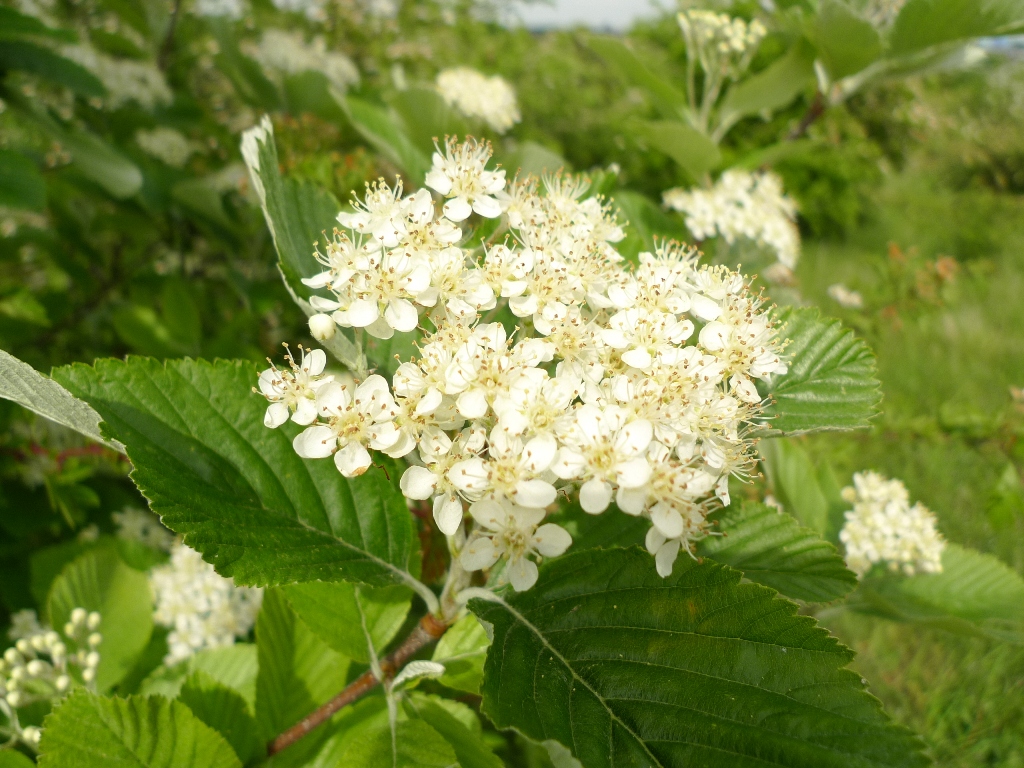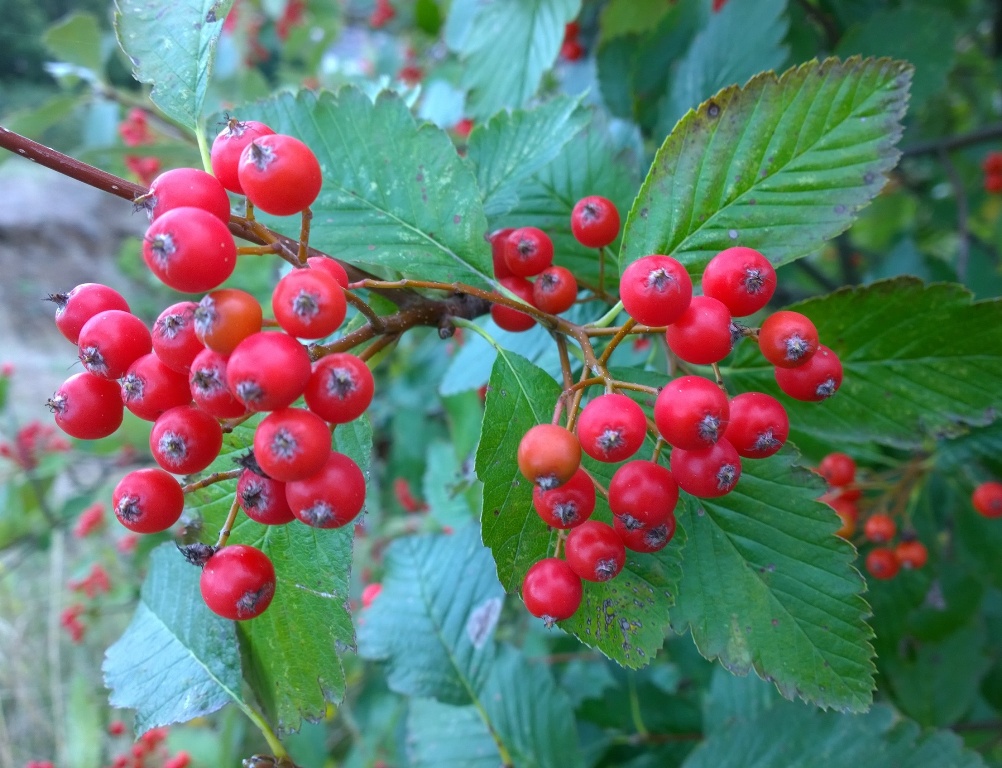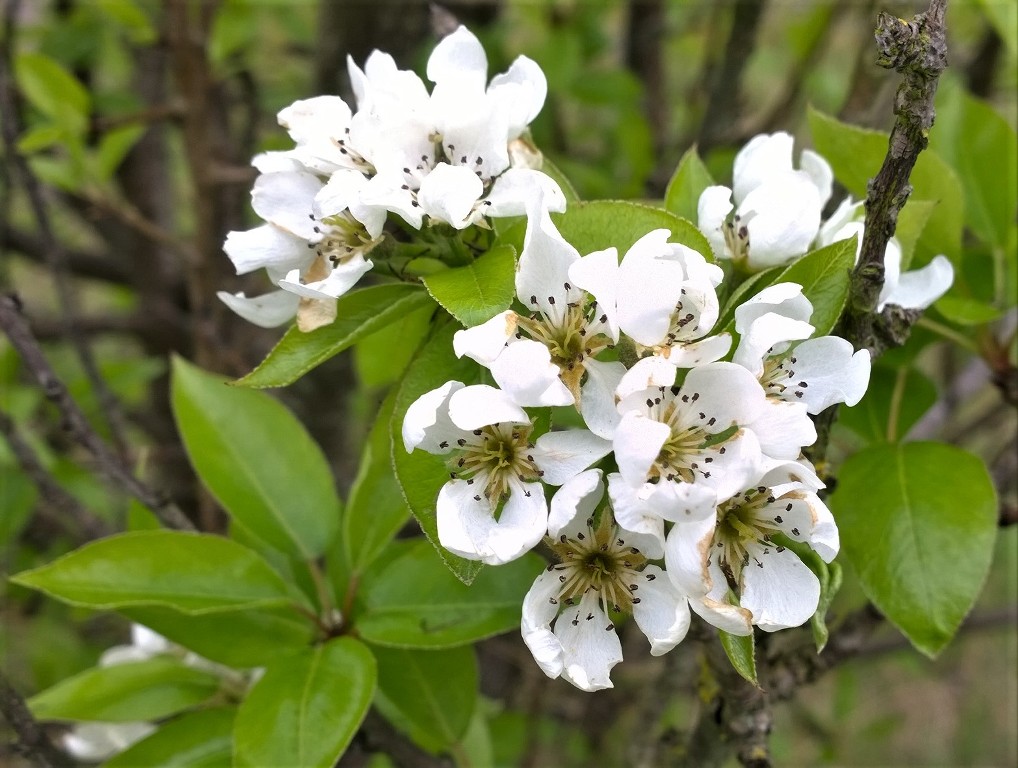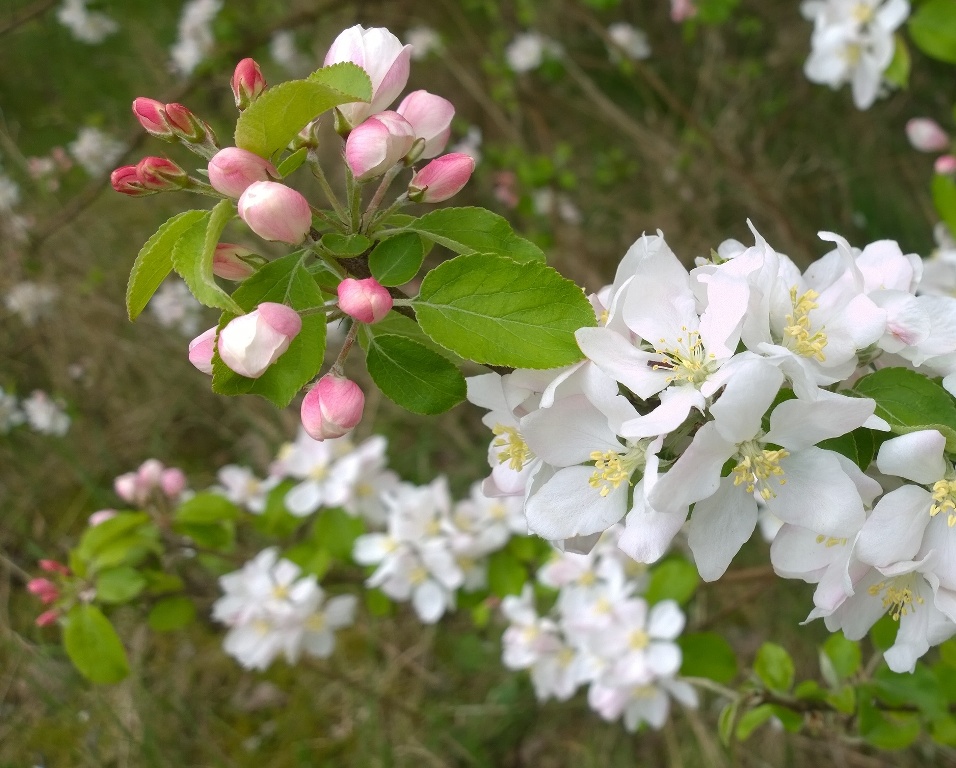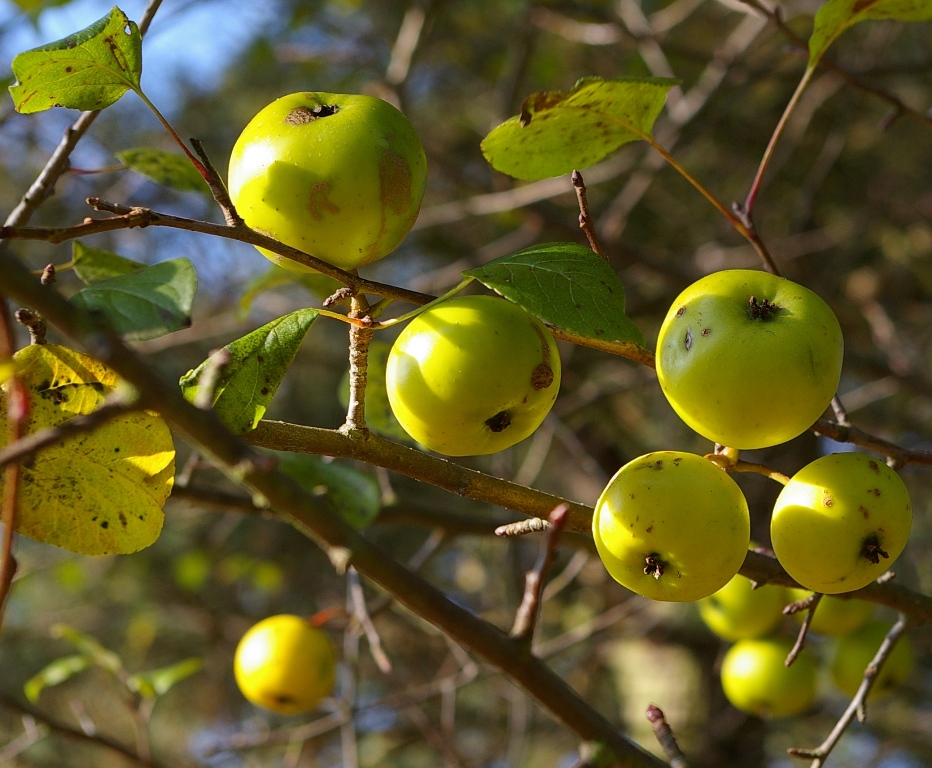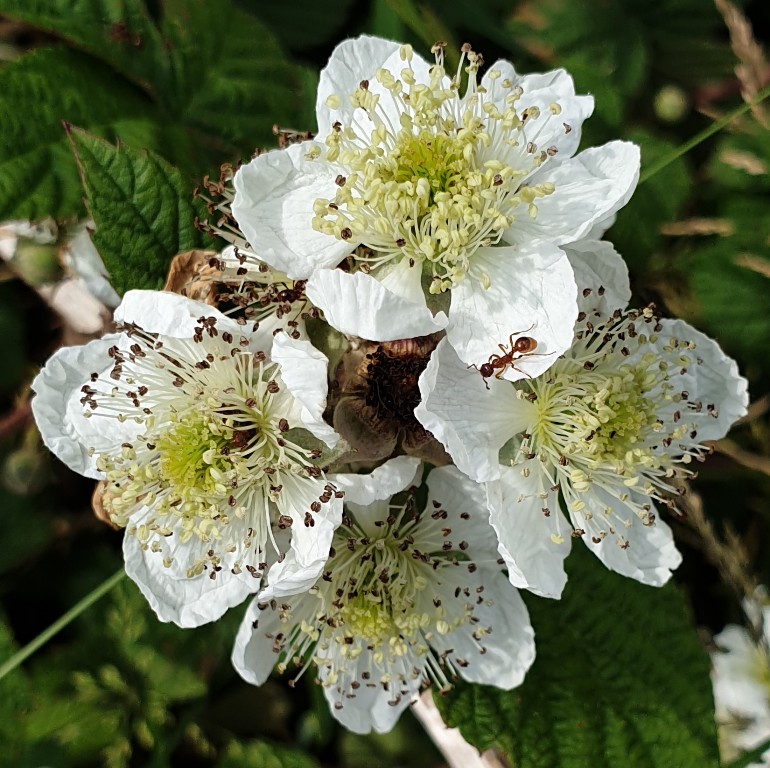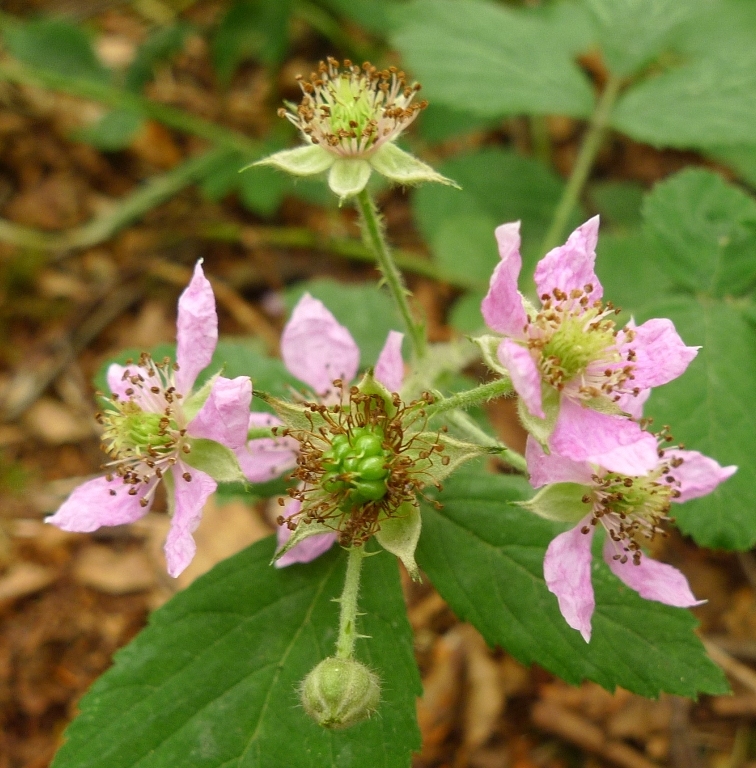Part 1; the woody plants in the rose family
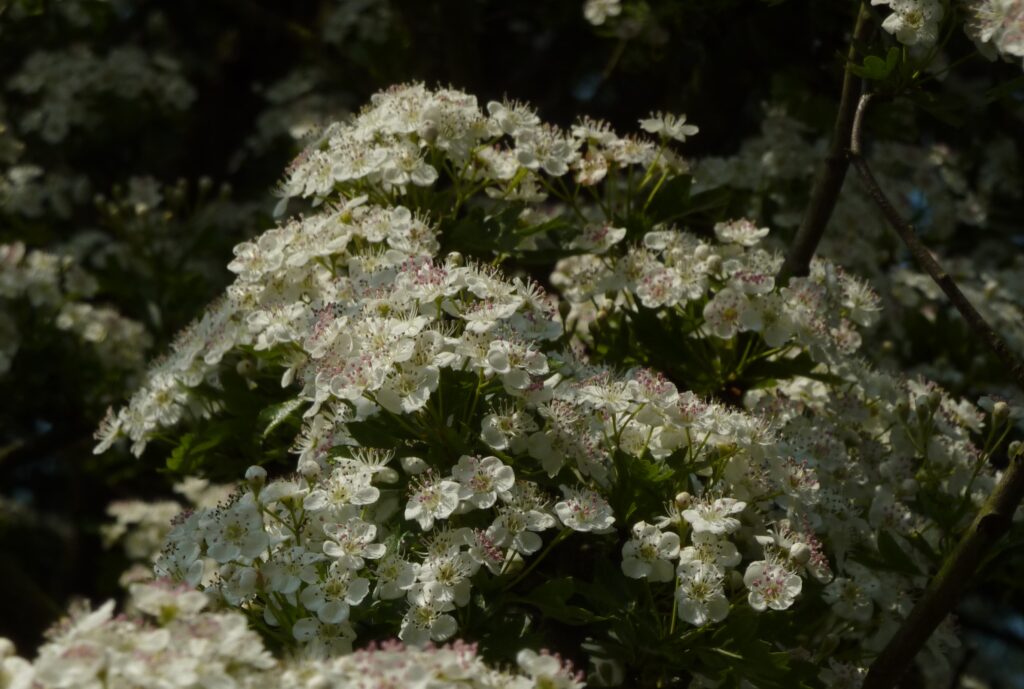
The Rosaceae or Rose family is a large and important family containing trees, shrubs, sub-shrubs and herbs. Although occurring worldwide, the greatest numbers of species are being found in the North Temperate region. This post will tell more about the uses of our native members of the Rosaceae.
In Stace it is family 48, so relative early in the evolution of the Flowering plants. It has 36 genera but several genera + species are introduced garden plants and of course are easily spread by the seeds in their fruits which are attractive as a food for birds in particular, spreading the plants far and wide into natural areas.
As this blog is not about ornamental plants but is about our useful ‘weeds’ I will use the order of genera mentioned in ‘The Wild Flower Key. This has less of those ornamental genera and species as mentioned in Stace. It has also lumped all the trees and shrubs together followed by the herbs.
This week we’ll start with all the native trees and shrubs in the Rose family.
Each plant described below for its uses will have a again a link on its scientific name of Wikipedia, which is general information worldwide, as well as the common name with information based for the British Isles, making it easy for you to learn more about the plant and see some pictures in case I haven’t provided one, either made by my friend Mike Poulton of Ecorecord or by my partner Matt Summers. The uses for all in the various groups will be added directly below the group rather than repeating at individual plants.
Have used some background colour coding with light blue for ‘Wildlife Uses‘ and pink for uses by us. The white background is for more general knowledge. Former Uses talks about the mythology and symbolism, which were so much more important in the past and forgotten about in our modern days.
Most info is copied with thanks from those beautiful websites provided in the links.
For all plants listed below their most important use maybe:
Wildlife Uses: The flowers provide pollen and nectar for insects, while the berries are eaten by birds. The insects are then also useful to us as the main pollinators!
Whitebeams, Service-trees and Rowan or Mountain Ash
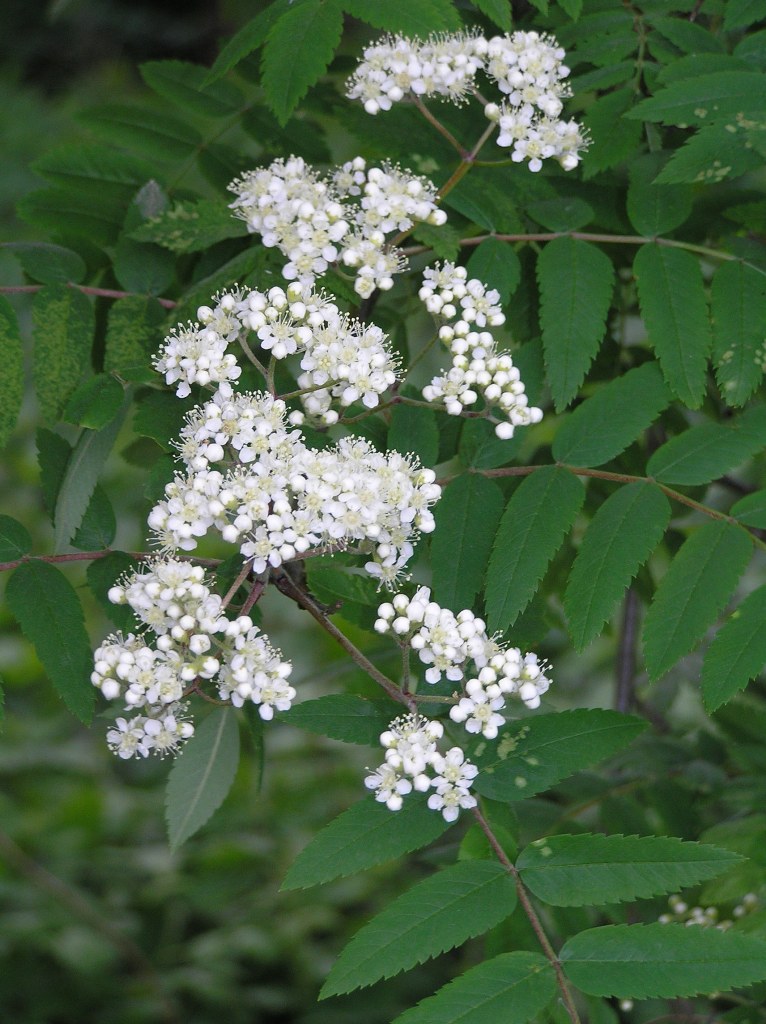
Sorbus aucuparia or Rowan (Mountain Ash)
Other Wildlife Uses: The leaves are eaten by the caterpillars of a number of moths, including the larger Welsh wave and autumn green carpet. Caterpillars of the apple fruit moth feed on the berries.
Former Uses:
Rowan was once widely planted by houses as a protection against witches. The colour red was considered to be the best colour for fighting evil, and so the rowan’s bright red berries have been associated with magic and witches. In Ireland, it was planted near houses to protect them against spirits, and in Wales rowan trees were planted in churchyards. Cutting down a rowan was considered taboo in Scotland.
The wood was used for stirring milk to prevent the milk curdling, and as a pocket charm against rheumatism. It was also used to make divining rods.
Other Uses: The wood is pale yellow-brown with a deeper-brown heartwood. It is strong, hard and tough, but not particularly durable. It is sometimes used in turnery, furniture, craftwork and engraving.
Rowan berries are edible to humans – they are sour but rich in vitamin C, and can be used to make a tart jam.
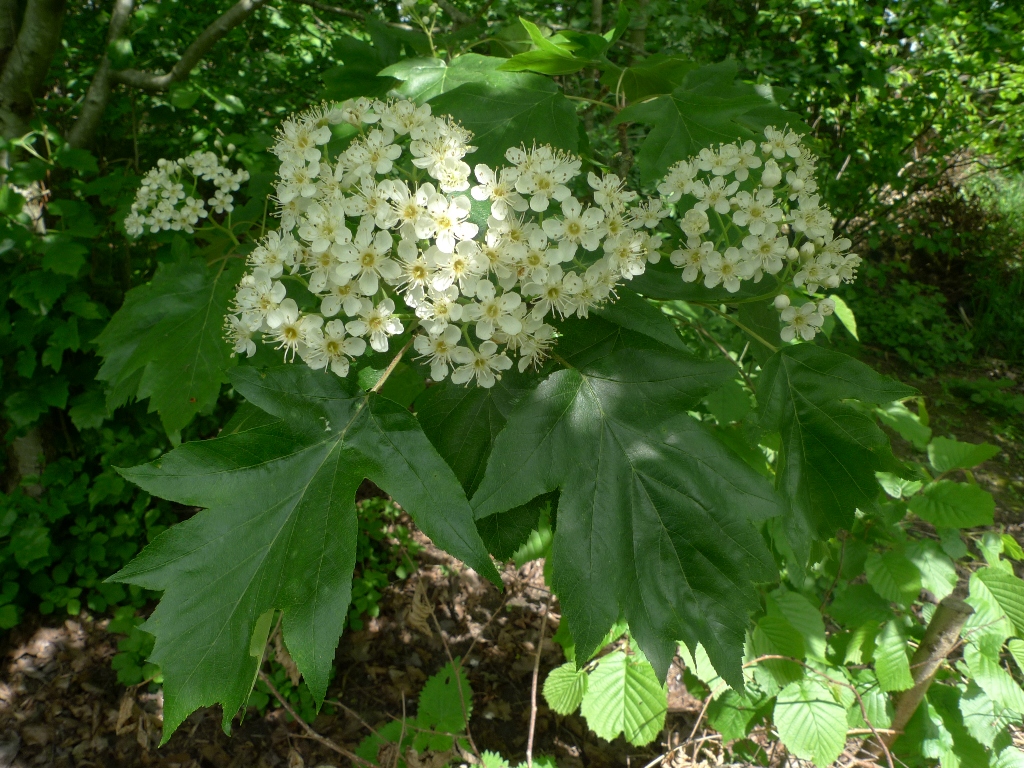
Sorbus torminalis or Wild Service-tree
Wildlife Uses: The leaves are eaten by caterpillars of the moths Bucculatrix bechsteinella and Phyllonorycter mespilella.
Former Uses: The fruits, also known as chequers, are said to taste like dates and were given to children as sweets. They can be made into an alcoholic drink and it is thought they influenced the naming of ‘Chequers Inns’, although it is unclear which came first – the name of the fruit or the inns.
Other Uses: The wood has a fine grain and silvery sheen, although it has never been widely used. The fruits can also be used to flavour other alcoholic drinks, such as whisky.
Sorbus aria agg. or Whitebeams
Other Wildlife Uses: The leaves are eaten by caterpillars of a number of moths, including Parornix scoticella, Phyllonorycter corylifoliella andPhyllonorycter sorbi.
Other Uses: Whitebeam timber is fine-grained, hard and white. Traditional uses included wood turning and fine joinery, including chairs, beams, cogs and wheels in machinery.
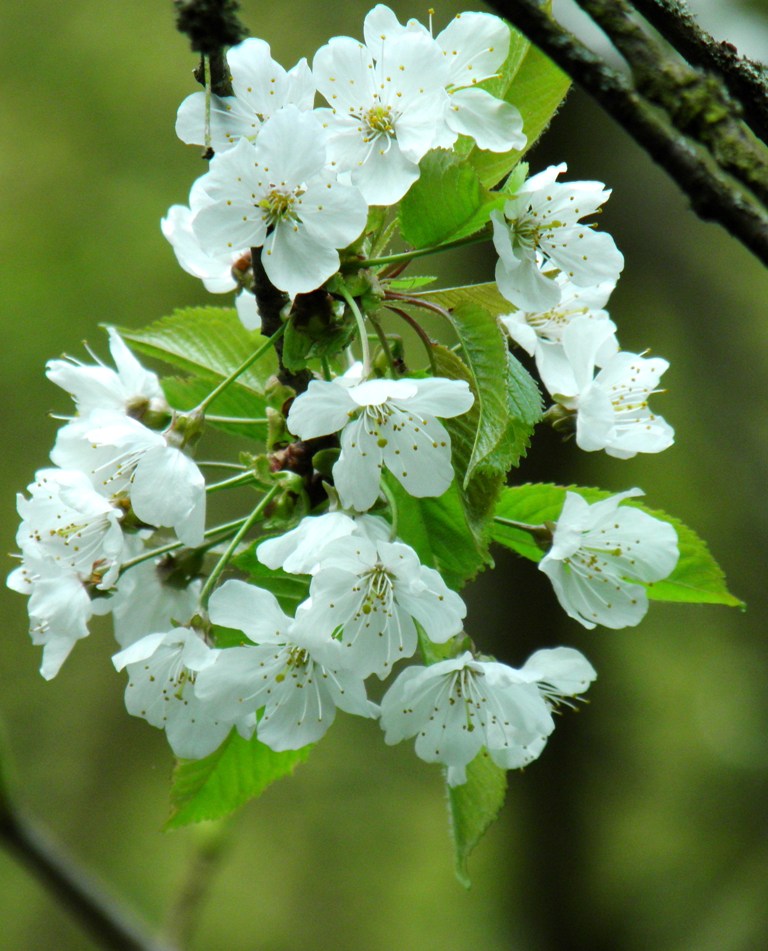
Other Wildlife Uses: Fruit is food for Birds as well as mammals, such as the badger, wood mouse, yellow-necked mouse and dormouse. The foliage is the main food plant for caterpillars of many species of moth, including the cherry fruit and cherry bark moths, the orchard ermine, brimstone and short-cloaked moth.
Former Uses: in Highland folklore, wild cherry had mysterious qualities, and to encounter one was considered auspicious and fateful. Traditionally, cherries were planted for their fruit and also their wood which was used for making cask hoops and vine poles. The sticky resin was thought to promote a good complexion and eyesight, and help to cure coughs.
Other Uses: Wild cherry has many cultivars and is a popular ornamental tree in gardens.
Cherry wood is used to make decorative veneers and furniture. The wood is hard, strong and honey-coloured, and can be polished to a good, shiny brown. The wood burns well and produces a sweetly scented smoke, similar to the scent of its flowers.
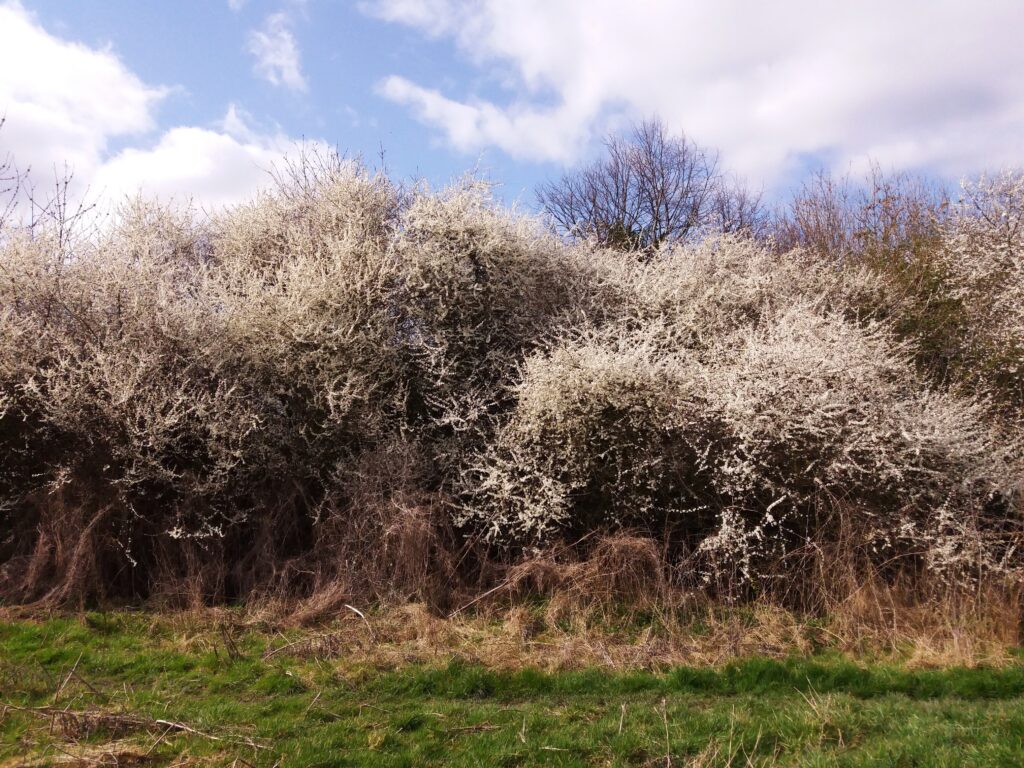
Other Wildlife Uses: Its foliage is a food plant for the caterpillars of many moths, including the lackey, magpie, swallow-tailed and yellow-tailed. It is also used by the black and brown hairstreak butterflies. Birds nest among the dense, thorny thickets, eat caterpillars and other insects from the leaves, and feast on the sloes in autumn.
Former Uses: Blackthorn was long associated with witchcraft, and it is said that witches’ wands and staffs were made using blackthorn wood.
It was traditionally used for making walking sticks and tool parts.
Traditionally, blackthorn was used in a wealth of remedies including tonics and syrups that ‘cleansed the blood’, aided digestive complaints and eased rheumatism. These tonics and syrups made use of the blackthorn’s bark, flowers and fruit.
Other Uses: It burns well so is a good choice for firewood. These days, the sloes are still used to make wine, preserves and sloe gin.
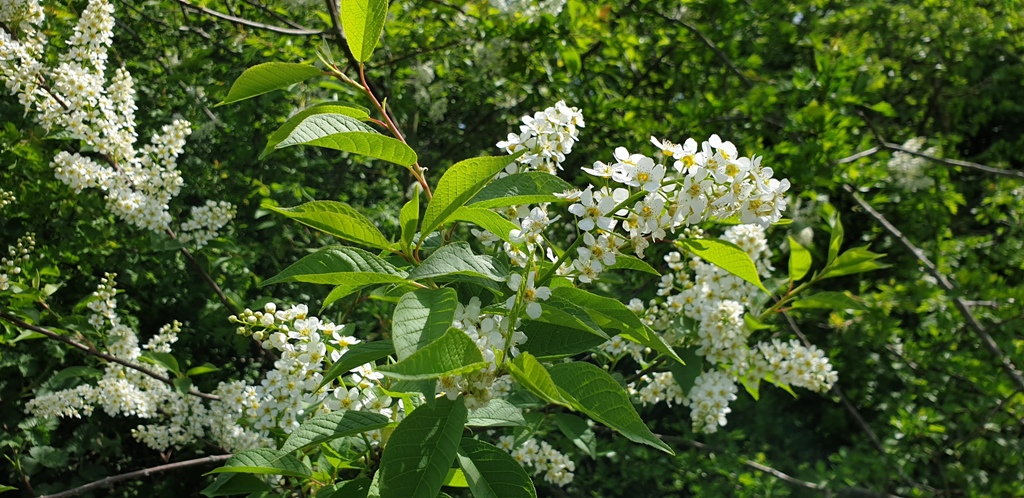
Other Wildlife Uses: Fruit eaten by birds as well as badger, wood mouse, yellow-necked mouse and dormouse. The foliage is eaten by caterpillars of many moth species, including the orchard ermine, brimstone and short-cloaked moth.
However, it is toxic to livestock, particularly goats.
Former Uses: If placed at the front door, the strong-smelling bark of the tree was believed to have magical properties that could ward off the plague.
Before industrial pesticides were available, the bark of bird cherry was used as a pesticide; the chemicals it contains protecting crops from rodent and insect attacks.
Bird cherry has been used medicinally in the past for the manufacture of cough medicine; eyewash to treat conjunctivitis; and to treat kidney stones, bronchitis, anaemia and many other ailments.
Other Uses: The black fruits can be used for making liqueur or for dyeing wool; while a reddish-brown dye made from the bark was once used to colour fishing nets.
Bird cherry wood is lighter and more finely textured than wild cherry and has been used for making small objects, such as wooden boxes and tool handles.
The “wild pears” of England and Wales are actually thought to be domesticates that escaped cultivation. They appear to be archaeophytes, with charcoal and carbonised pips having been found at several Neolithic sites and are occasionally mentioned in medieval documents. It is likely that pears spread to Britain after their domestication with early farmers and subsequently escaped into the wild. Its establishment in the British Isles is probably due to human migration, with the trees belonging to one of the Pyrus communis subspecies instead of the true wild pear species of P. pyraster, which is native to much of continental Europe but absent from Britain.
Pyrus cordata or Plymouth Pear
Another species of pear found wild in South West England, the Plymouth pear (Pyrus cordata), is now thought to have originated from hedging plants imported from Brittany.
Other Wildlife Uses: Once ripe, the fruit becomes much fleshier and is a food source for wildlife and a favourite with local blackbirds.
Other Uses: Fruit is rather hard and astringent at first, but bletts as soon as it falls from the tree and then has quite a good flavour, becoming soft and quite juicy.
Malus sylvestris or Crab Apple
The common Apple or M. pumila can often be found in hedges, scrub and waste ground throughout the BI and is much more common than M. sylvestris.
Other Wildlife Uses: The crab apple is one of the few host trees to the parasitic mistletoe,Viscum album, and trees are often covered in lichens. The leaves are food for the caterpillars of many moths, including the eyed hawk-moth, green pug, Chinese character and pale tussock. Mammals, such as mice, voles, foxes and badgers, also eat crab apple fruit.
Former Uses and Mythology: Crab apples have long been associated with love and marriage. It was said that if you throw the pips into the fire while saying the name of your love, the love is true if the pips explode. Apple wood was burned by the Celts during fertility rites and festivals, and Shakespeare made reference to crab apples in A Midsummer Night’s Dream and Love’s Labour Lost.
In Ireland, a yellow dye was extracted from the bark to colour wool.
Other Uses: The trees are often planted in commercial orchards as their long flowering period makes them excellent pollination partners for cultivated apples. The fruit can be roasted and served with meat or added to ales or punches. More commonly, it is used to make crab apple jelly and as a natural source of pectin for setting jams.
The pinkish wood has an even texture and makes good quality timber, lending itself particularly well to carving and turning. It also makes a sweetly scented firewood.
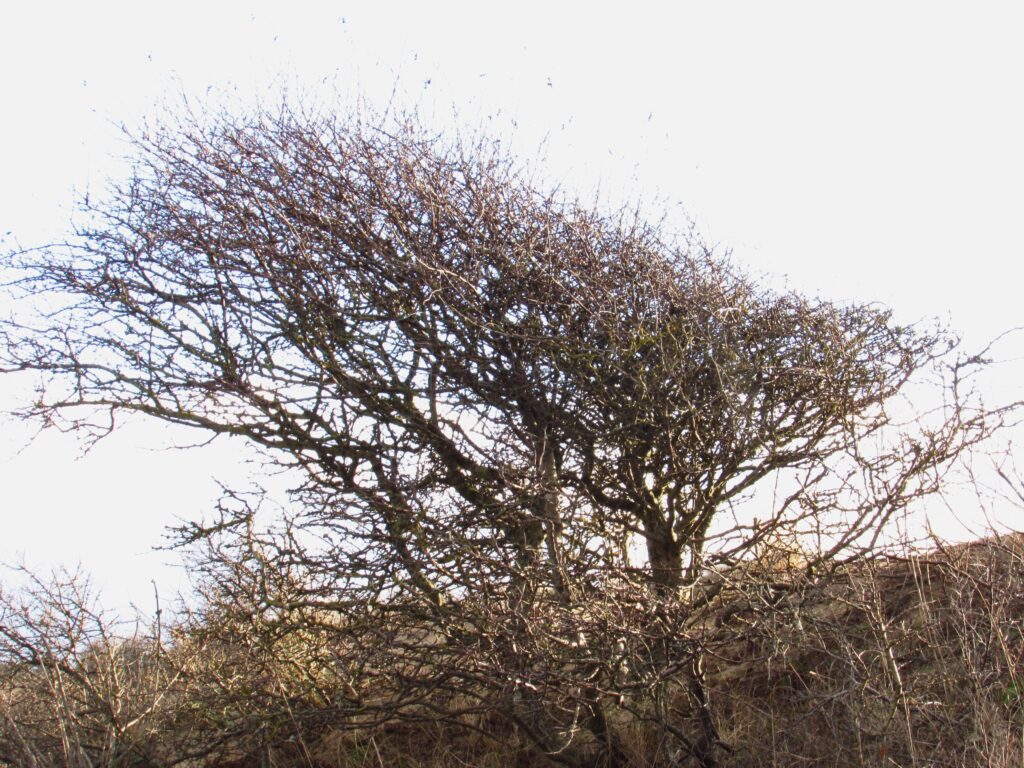
Crataegus monogyna or Hawthorn ( also see blog of Eatweeds)
Other Wildlife Uses: Common hawthorn can support more than 300 insects. It is the foodplant for caterpillars of moths, including the hawthorn, orchard ermine, pear leaf blister, rhomboid tortrix, light emerald, lackey, vapourer, fruitlet-mining tortrix, small eggar and lappet moths. Its flowers are eaten by dormice and provide nectar and pollen for bees and other pollinating insects. The haws are rich in antioxidants and are eaten by migrating birds, such as redwings, fieldfares and thrushes, as well as small mammals.
The dense, thorny foliage makes fantastic nesting shelter for many species of bird.
Former Uses and Mythology: Hawthorn is a pagan symbol of fertility and has ancient associations with May Day. It was the ancestor of the Maypole and its leaves and flowers the source of May Day garlands as well as appearing in the wreath of the Green Man.
Hawthorn was never brought into the home. It was believed that bringing hawthorn blossom inside would be followed by illness and death, and in medieval times it was said that hawthorn blossom smelled like the Great Plague. Botanists later learned that the chemical trimethylamine in hawthorn blossom is also one of the first chemicals formed in decaying animal tissue, so it is not surprising that hawthorn flowers are associated with death.
Its blossoming marks the point at which spring turns into summer, and the old saying ‘Cast ne’er a clout ere May is out’ almost certainly refers to the opening of hawthorn flowers rather than the end of the month.
Other Uses: Common hawthorn timber is a creamy-brown colour, finely grained and very hard. It can be used in turnery and engraving and to make veneers and cabinets, as well as boxes, tool handles and boat parts. It also makes good firewood and charcoal, and has a reputation for burning at high temperatures.
The young leaves, flower buds and young flowers are all edible. They can be added to green salads and grated root salads. The developing flower buds are particularly good. The haws can be eaten raw but may cause mild stomach upset. They are most commonly used to make jellies, wines and ketchups.
It has long been grown as a hedging plant and is a popular choice in wildlife gardens.
Crataegus laevigata or Midland Hawthorn
Other Wildlife Uses: The haws provide a valuable food source for many small birds and insects, including thrushes, hawthorn shield bugs and yellowhammers. The dense thickets also provide shelter for small mammals such as wood mice and are used by birds as nesting sites.
Former Uses: When cut, the flowers have such a foul smell that medieval people said it reminded them of the stench of the Great Plague.
Other Uses: The wood from the Midland hawthorn, particularly the fluted stems, is used for tool handles and walking sticks. It is often planted as hedging in wildlife gardens as its heavy thickets provide good shelter and act as effective screens.
The red haws can be used to make jellies, chutneys and wine.
Cotoneaster: This is a huge genus with many ornamental garden plants often escaped into our countryside.
Cotoneaster cambricus or Wild Cotoneaster
This is the only endemic Cotoneaster found in the Great Orme, North Wales.
Classified as ‘Critically Endangered’ in the latest Red Data List due to the very small number of plants surviving in the wild. Until recently, the origin of this species was uncertain and some regarded it as an escape from nearby gardens. However, DNA analysis has now shown it to be a distinctive and unique species. Because of this ambiguity, though, it doesn’t currently have any legal protection.
Most of the surviving wild bushes exhibit evidence of grazing by from the feral population of Kashmir goats introduced to the Great Orme by the Victorians. Some bushes are now enclosed in metal cages to protect them. Some highly invasive non-native species of Cotoneaster pose an additional threat as they occupy the same habitat as Great Orme Berry.
In Welsh it has the rather beautiful name Creigafal y Gogarth, meaning “rock apple of Gogarth” (Gogarth being the original Welsh name for the Great Orme).
Rosa or wild Roses
Uses: All roses are beautiful for gardens and hedges and form food for insects, birds and mammals as well as for us:
Rose hips are occasionally made into jam, jelly, marmalade, and soup or are brewed for tea, primarily for their high vitamin C content. They are also pressed and filtered to make rose hip syrup. Rose hips are also used to produce rose hip seed oil, which is used in skin products and some makeup products.
There are over three hundred species worldwide and tens of thousands of man-made cultivars. Britain has just got 4 native species and one introduced and naturalized, some say invasive species.
Rosa spinosissima or Burnet Rose
In emblematic terms the Burnet Rose is particularly associated with Scotland, where it is traditionally referenced in poetry and song, and is a symbolic native plant second only to the thistle.
Rosa rubiginosa or Sweet-briar
I love this rose due to that the foliage has a strong apple-like fragrance! Graham Thomas recommends that it should be planted on the south or west side of the garden so that the fragrance will be brought into the garden on warm, moist winds.
Rosa canina or Dog-rose
This is probably the best known native rose.
Uses: The flesh (shells) of rose hips from dog roses contain high levels of antioxidants, mainly polyphenols and ascorbic acid, as well as carotenoids and vitamins B and E. Rose hips contain a high amount of carotenoids and ascorbic acid along with natural sugars, organic acids, polyunsaturated fatty acids, phenolics, and essential oil, making them excellent for consumption as functional foods, natural pharmaceuticals, and cosmo-nutraceuticals. Rose hip essential oil is composed mainly of alcohols, monoterpenes and sesquiterpenes.
The fruit is noted for its high level of vitamin C, and is used to make syrup, tea, and marmalade. It has been grown or encouraged in the wild for the production of vitamin C from its fruit (often as rose-hip syrup), especially during conditions of scarcity or during wartime. The species has also been introduced to other temperate latitudes.
Forms of this plant are used as stocks for the grafting or budding of cultivated roses. The wild plant is used for stabilising soil in land reclamation and specialised landscaping schemes.
Numerous cultivars have been named, though few are common in cultivation. The cultivar Rosa canina ‘Assisiensis’ is the only dog rose without thorns.
Medicinal interest in rose hips has increased as a consequence of research that has explored the potential application of rose hips for treatment of several diseases including skin disorders, hepatotoxicity, renal disturbances, diarrhoea, inflammatory disorders, arthritis, diabetes, hyperlipidaemia, obesity and cancer. In history, residue products from rose hips have been used as animal fodder, but now are being explored and gaining an important role in cosmetics, pharmacology and in food applications as they contain oil with a high degree of unsaturated lipids.
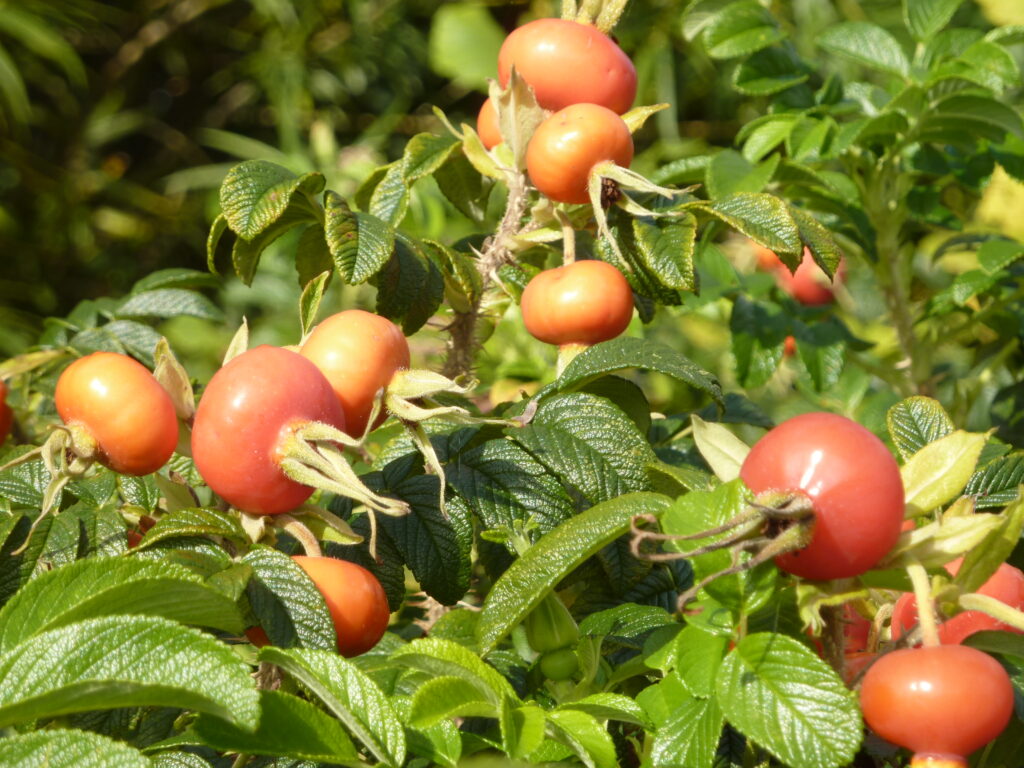
Rosa rugosa or Japanese Rose
This is my favourite non native ‘wild rose’. And therefore a bit more information:
It grows in poor soils has very fragrant flowers and beautiful large hips + autumn colour! Rosa rugosa is naturalized in many parts of Europe, and it is considered an invasive species in some habitats, particularly in seashores of Northern Europe.
Rosa rugosa is widely used as an ornamental plant. It has been introduced to numerous areas of Europe and North America.
Other Uses: The sweetly scented flowers are traditionally used to make flower jam and dessert in China. They are also used to make pot-pourri in Japan and China. It is used in traditional Chinese medicine to treat irregular menstruation and gastritis.
This species hybridisis readily with many other roses, and is valued by rose breeders for its considerable resistance to the diseases rose rust and rose black spot. It is also extremely tolerant of seaside salt spray and storms, commonly being the first shrub in from the coast. It is widely used in landscaping, being relatively tough and trouble-free. Needing little maintenance due to it being very disease resistant, it is suitable for planting in large numbers; its salt-tolerance makes it useful for planting beside roads which need deicing with salt regularly.
Numerous cultivars have been selected for garden use, with flower colour varying from white to dark red-purple, and with semi-double to double flowers where some or all of the stamens are replaced by extra petals. Popular examples include ‘Rubra Plena’ (semi-double variant, with strong clove scented dark pink petals and dark green wrinkled leaves and large round orange-red hips), ‘Hansa’ (very fragrant, red-purple double), ‘Fru Dagmar Hastrup’ (pink, single), ‘Pink Grootendorst’ (pink, semi-double), ‘Blanc Double de Coubert’ (white, double) and the more common ‘Roseraie de L’Haÿ’ (pink, double), which is often used for its very successful rootstock and its ornamental rose hips.
Rubus spp. or Brambles
These include the useful Blackberry, and Raspberry.
Rubus agg. or Rubus fruticosa as it was formerly known. Its common name can be a Blackberry for its positive virtues or Bramble for its prickly virtues!
It has many named cultivars for garden use.
I’ve done a separate blog post on the Blackberry as there is too much information about this particular woody Rosaceae!
Rubus saxatilis or Stone Bramble
Edible Uses:
Fruit – raw or cooked. An acid flavour, but agreeable to the palate.
Medicinal Uses:
A decoction of the root is useful in the treatment of relaxed bowels and dysentery, and also in treating the spasmodic stage of whooping cough. The leaves are astringent and a decoction is used to treat dysentery and some types of bleeding.
Edible Uses:
The fruit of R. idaeus is an important food crop, though most modern commercial raspberry cultivars derive from hybrids between R. idaeus and R. strigosus. The fruits of wild plants have a sweet taste and are very aromatic.
It has many named cultivars for garden use. There are summer and autumn varieties. See for some here.
Medicinal Uses:
Red raspberries contains 31 μg/100 g of folate. Red raspberries have antioxidant effects that play a minor role in the killing of stomach and colon cancer cells.
Young roots of Rubus idaeus prevented kidney stone formation in a mouse model of hyperoxaluria. Tiliroside from raspberry is a potent tyrosinase inhibitor and might be used as a skin-whitening agent and pigmentation medicine.
Raspberry fruit may protect the liver.
So these were all the native woody plants in the Rosaceae, next time all the herbaceous ones…..

